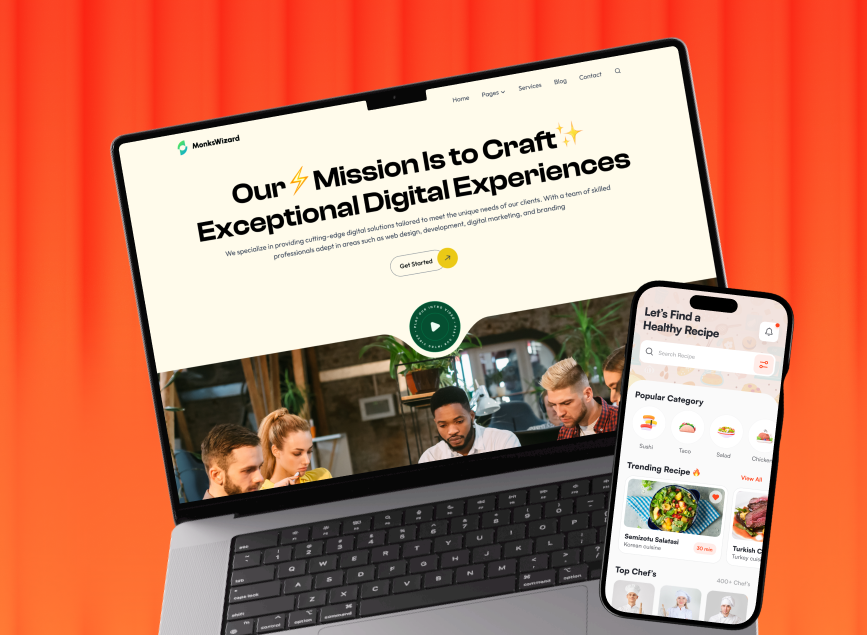
Key Takeaways
- Good mobile UX keeps users engaged, improves retention, and boosts overall satisfaction.
- Clear navigation, minimal clutter, and content priority make mobile apps more usable.
- Touch-friendly layouts and one-hand usability improve comfort across all device types.
- Personalization, offline access, and contextual help significantly enhance user experience quality.
- Continuous testing and performance optimization ensure stable, fast, and user-friendly app experiences.
Do you know that 90% of smartphone users like to interact with an app or site if it has a good UX? A well-designed app can effectively attract users and keep them engaged. So, there is no way to ignore mobile app UX design if you want the app to shine.
Now, the question you might get is how to improve the UX quality on a mobile app, right? Well, that might be tricky but not rocket science. There are some effective practices pro-designers follow for an up-to-the-mark mobile UX design.
How about you try it on your work? Take my word for it, those tricks will help you. So, let's learn how to improve your mobile UX design with the best practices skilled designers follow.
What Is UX Design for Mobile Apps?
UX (User Experience) design for mobile apps usually focuses on creating intuitive, efficient, and enjoyable experiences for users interacting with smartphones. It covers the entire process of developing a mobile app, from understanding user needs and behaviors to creating a seamless, user-friendly interface.
To design a mobile app, it's a must-have to implement the core UX elements. Let's have a quick glance over the key elements to focus on:

- Color: A consistent color scheme usually reflects your brand's identity. Colors should create a visually pleasing interface and ensure high contrast for readability and accessibility.
- Font: A good app should have clear and legible fonts. Use appropriate sizes for different text elements. Consistency in font usage helps in creating a cohesive look and feel.
- Icons: Use simple and easily recognizable icons. Icons should convey their function at a glance. Consistency is essential in this case as well.
- Illustrations: Beautiful and relevant illustrations can make the app more engaging. Make sure to use relevant elements and add value to the user experience. Also, avoid overuse to keep the app uncluttered.
- Brand Design: It's essential to make the app's design with your brand's overall aesthetic. These elements include color schemes, fonts, and visual elements.
- Input Controls: There should be input controls like buttons, checkboxes, and text fields to make things easier to use. They should be appropriately sized for touch interaction. Provide clear feedback when users interact with them.
- Navigational Components: Intuitive navigation elements like menus, tabs, and buttons are fundamental. Navigation should be straightforward and consistent throughout the app.
- Informational Components: Relevant components like tooltips, progress bars, and notifications are essential to guide users. They provide essential information and feedback to make sure that they are noticeable but not intrusive.
- Containers: Appropriate use of containers like cards and grids helps organize content. Containers also help in creating a clean and structured layout. They make it easier for users to find and interact with information.
Best Practices for Mobile App UX Design
Now, let’s pin down to cut the chase. Here, I am adding 15 best UX practices for mobile apps. Each of them is significant separately and no matter what type of app you are designing, they all matter equally.
1. Make Simple Navigation
Regardless of the app type, you should always make sure that users can navigate it easily and that there are no complexities. Simple navigation significantly improves user experience as it makes things easier for users to find what they need.

Complex or confusing navigation can frustrate users and make them uninstall the app. You should create intuitive, straightforward navigation, and designers to ensure users can effortlessly move through the app. It'll help you get higher user satisfaction and retention rates.
2. Reduce Clutter on the UI
Reduced clutter on your mobile UI can improve usability and user satisfaction. A cluttered interface can overwhelm users and make it difficult to focus on key tasks. It can result in a frustrating experience for users.
That's why you should minimize unnecessary elements and focus on what truly matters. Your aim should be to create a clean, efficient interface that guides users smoothly through the app. Streamlined designs help users quickly find what they need which ultimately boosts user engagement and retention.
3. Focus on Content Priority
Next, you need to prioritize key content on your mobile UI. It simply ensures that users can access the most important information quickly and easily. Remember that mobile screens are small, so it can be tricky to highlight the most critical content. Still, you need to make it to avoid overwhelming users with too much information at once.
Here, my suggestion is to place essential elements in prominent positions strategically. Thus, you can direct users' attention to what matters most. This approach will enhance their overall experience. Also, this practice makes the app more user-friendly and guides users toward desired actions.
4. Make the UI Suitable for Human Fingers
You should also design the mobile UI for human fingers. It is important because it directly impacts usability and comfort. Usually, mobile devices are operated with touch, so the interface must be easy to interact with using fingers of different sizes.

Make sure that buttons and touch targets are not too small or too close together. Otherwise, it'll result in frustration and errors. You can create touch-friendly designs with adequately sized buttons and spacing to ensure that users can navigate the app effortlessly and accurately.
5. Check How It Goes with One-Handed Use
You, me, and most other people use their smartphones in one hand, right? So, you need to make sure that it works perfectly without the help of our other hand. Otherwise, people won't find it a user-friendly app.
To design an app for one-handed use, you need to place major elements within easy reach of the thumb. Don't forget that people are two types: left-handed and right-handed.
So, make the design in a way so both users can find it comfortable to use. This approach will improve accessibility and convenience to make the app more user-friendly and adaptable to different situations.
6. Optimize the App for Overall Performance
You need to optimize the app properly. Focus on facts like slow load times and lagging interactions that frustrate users. These facts can result in a poor experience and potential abandonment.
Users expect apps to be fast and responsive. So, you need to focus on performance optimization to ensure that the app runs smoothly and provides a seamless experience that keeps users engaged.
Make sure to prioritize efficient coding, minimize resource usage, and regularly test performance. These practices significantly enhance user satisfaction and retention.
7. Personalize the Experience for Users
It is better to personalize the experience for users to make the app more relevant and engaging. Generally, users appreciate when an app recognizes their preferences and behaviors. It offers custom content and features for all types of users.
Proper personalization can amplify user satisfaction, loyalty, and engagement. This practice greatly makes the users feel valued and realized. If you can utilize data and insights to customize the app experience, it can create a meaningful interaction. Ultimately, it will bring higher user retention to achieve business goals.
8. Try to Offer Offline Functionality
If you can offer offline functionality, it can ensure that the users can access and use the app without an internet connection. This feature amplifies the app's reliability and convenience. Thus, it makes things more versatile and appealing to users who may not always have reliable internet access.
Also, as a designer, you should improve user satisfaction and loyalty with offline facilities. With offline access, users can continue to interact with the app anytime. This flexibility can set your app apart from competitors and increase its usability and appeal.
9. Provide Clear Error Messages
It is essential to provide clear error messages because it helps users understand and resolve issues quickly. Ambiguous or technical error messages can confuse and frustrate users. As a result, they might have negative experiences.
You should always relay clear, concise, and user-friendly error messages. It will guide users on what went wrong and how to fix it. Also, it will reduce frustration and improve the overall user experience. Moreover, this approach will encourage the users to continue using it even when issues come by.
10. Familiar UI Patterns Make Users Comfortable
Familiar UI patterns are another practice that is underrated yet effective. It’s because people find comfort and trust in something familiar. The approach is about using users’ existing knowledge and expectations from other apps.

Consistent and recognizable design elements can help users navigate the app intuitively. Also, they don't need to learn new patterns or behaviors. This type of familiarity reduces the learning curve and amplifies usability.
Moreover, it can pave the way to a smooth and enjoyable user experience. If you can add well-known UI patterns, you can create a sense of ease and confidence for users. Also, it will greatly uplift them to engage more deeply with the app.
11. Don’t Forget that Mobiles Have Different Screen Sizes
You must keep in mind that mobiles have different screen sizes while designing. It is essential because it confirms the app can provide a consistent experience across different models. A one-size-fits-all approach can cause usability issues and poor user experience on certain devices.
You should design responsive layouts and scalable elements. It will help the app to adapt seamlessly to different screen sizes and resolutions. This flexibility fact can improve accessibility and user satisfaction. At the same time, the app remains functional and visually appealing on any device.
12. Try to Provide Contextual Help
You must try to provide contextual help. It is important because it supports users when they need assistance. So, it can enhance their experience and reduce frustration. Additionally, contextual help offers relevant information and guidance within the app. It lets the users understand features and complete tasks more efficiently.
Here, you can add helpful tips, tooltips, and guides at appropriate points to make the app more user-friendly and intuitive. This approach simply improves usability and finally results in higher satisfaction and retention rates.
13. Make Sure to Check Voice Input
Checking voice input is another must-have you can't ignore. It's because voice commands are becoming increasingly popular for interacting with mobile devices. Voice input usually offers convenience and accessibility. It lets users perform tasks hands-free.

Well, you should make sure that your app accurately recognizes and responds to voice commands. This practice can significantly enhance user experience, particularly for users with disabilities or those who prefer voice interactions.
Also, you need to go for continuous testing and refining voice input functionality to create a more inclusive and versatile app. This way, you can make the app feel appealing to a broader audience and stay ahead in a competitive market.
14. Understand Split Screens
The next thing to follow is understanding split screens. It's because users often multitask on their mobile devices. Split screen functionality allows users to run two apps simultaneously. It enhances productivity and convenience.
In this case, you need to ensure that their app performs well in split-screen mode. For that, maintain usability and functionality even when sharing the screen with another app. Also, try to optimize the app for split-screen use to provide a seamless experience that meets users' multitasking needs.
15. Continuously Test and Iterate
The final target is to test and iterate for further improvement. This practice ensures the app remains user-friendly and free of bugs. As we know, the mobile environment is dynamic, with frequent updates to operating systems and user expectations.
When you regularly test the app, you can easily identify and fix issues, improve performance, and incorporate user feedback. The iterative design also lets you continuously improve and keep the app relevant to meet users' evolving needs.
Smart UX Tips for Your Mobile
Great UX isn’t just about getting the basics right, it’s about going the extra mile. Once your foundation is solid, use these smart tips to take your app experience to the next level:
Use Micro Iteractions to Guide Users
Tiny animations or visual cues can make the app feel more responsive and engaging. Use them to confirm actions, show transitions, or provide feedback.
Add a Dark Mode Option
Dark mode isn't just trendy, it improves usability in low-light settings and saves battery life. Give users the flexibility to choose what suits them best.
Localize for Different Regions
If your app serves global users, adapt the content, date formats, and language for different regions. Localization enhances comfort and trust.
Enable Gesture-Based Controls
Swiping, pinching, or long-pressing can make navigation faster and more fun. Just make sure gestures are intuitive and come with visual cues.
Use Data Visualization for Progress
Whether it’s workout goals, savings, or learning streaks, visualizing user progress boosts motivation. Use clean charts or progress rings to show achievements at a glance.
Why UX Matters for Mobile Apps?
I guess you have already got some idea of why UX is mandatory for a mobile app. Still, you should learn why mobile-friendly UX design strategy matters for business growth. Here’s how a good UX can help you grow your business with the app.

Enhanced User Retention
High retention rates mean users stick around longer. It results in more opportunities for interaction and revenue. A good UX design makes the app easy and comfortable to use. Users will likely return to an app that offers a smooth and intuitive experience.
Increased User Engagement
You can only expect higher engagement from increased usage and greater customer satisfaction. An app with excellent UX keeps users engaged. Engaging features, simple navigation, and attractive design encourage users to spend more time on the app.
Higher Conversion Rates
UX design directly impacts conversion rates. When users find an app easy to navigate, they are more likely to complete actions like making a purchase or signing up for a service. Clear calls to action and simple processes can significantly boost conversions.
Improved Brand Loyalty
Users associate their experience with the app with the brand itself. A positive UX on the app improves trust and loyalty. Satisfied users are more likely to become repeat customers. This loyalty later results in long-term business growth.
Reduced Support Costs
A well-designed app can minimize user confusion and errors. Users need less assistance, which reduces the need for continuous customer support. Fewer support requests mean lower operational costs and more resources available for other business areas.
Investing in startup UX design strategies for mobile apps is essential. It can significantly boost user retention, engagement, and conversions while building brand loyalty, reducing support costs, and generating positive word-of-mouth marketing.

FAQs
How does UX design reduce support costs?
A well-designed app minimizes user confusion and errors. Thus, it reduces the need for customer support. Fewer support requests lower operational costs and free up resources for other business areas.
How does mobile UX design generate positive word-of-mouth marketing?
Satisfied users share their positive experiences with others which results in word-of-mouth marketing. Personal recommendations attract new users and enhance the app’s reputation, as new users often trust recommendations more than traditional advertising.
How can businesses invest in UX design for mobile apps?
Businesses can invest in UX design by hiring skilled design agencies like Design Monks. They conduct user research and continuously test and refine the app. By focusing on user feedback and staying updated with design trends, they can create a superior user experience for your mobile app.
how do I make my mobile app UX effective?
To make your mobile app UX effective, focus on simple navigation, fast loading, touch-friendly design, personalized content, and responsive layouts. Test continuously, minimize clutter, and guide users with clear feedback to ensure a smooth experience.
End Note
You must understand that mastering mobile app UX design is mandatory for creating engaging and user-friendly applications. Implementing all these best practices might be difficult if you are not a professional designer. Still, you must pay attention to these facts.
If things are tough for you, the best solution is to hire a good UX design agency like Design Monks. Best wishes for your outstanding mobile app.

.svg)






.png)
.png)
.avif)
.png)


.png)
.png)
.png)
.png)



.avif)



